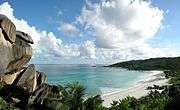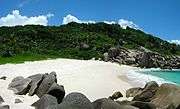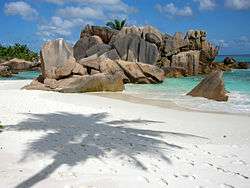La Digue
 La Digue | |
| Geography | |
|---|---|
| Location | Seychelles, Indian Ocean |
| Coordinates | 4°22′48″S 55°50′48″E / 4.38000°S 55.84667°ECoordinates: 4°22′48″S 55°50′48″E / 4.38000°S 55.84667°E |
| Archipelago | Inner Islands, Seychelles |
| Adjacent bodies of water | Indian Ocean |
| Total islands | 1 |
| Major islands |
|
| Area | 10.08 km2 (3.89 sq mi) |
| Length | 5 km (3.1 mi) |
| Width | 3.3 km (2.05 mi) |
| Coastline | 15.4 km (9.57 mi) |
| Highest elevation | 333 m (1,093 ft) |
| Highest point | Belle Vue (Eagle's Nest Mountain) |
| Administration | |
| Group | Inner Islands |
| Sub-Group | Granitic Seychelles |
| Districts | La Digue and Inner Islands |
Largest settlement |
La Passe (population ~2500) |
| Demographics | |
| Demonym | Creole |
| Population | 2800 (2014) |
| Pop. density | 278 /km2 (720 /sq mi) |
| Ethnic groups | Creole, French, East Africans, Indians. |
| Additional information | |
| Time zone | |
| Official website |
www |
| ISO Code = SC-15 | |
|
La Digue Lighthouse | |
| Location |
La Digue Seychelles |
|---|---|
| Coordinates | 4°20′51.9″S 55°49′31.6″E / 4.347750°S 55.825444°E |
| Construction | masonry building |
| Tower shape | square prism small building with a mast atop |
| Markings / pattern | white building |
| Height | 3 metres (9.8 ft) |
| Focal height | 6 metres (20 ft) |
| Light source | solar power |
| Range | 5 nautical miles (9.3 km; 5.8 mi) |
| Characteristic | Fl W 5s. |
| Admiralty number | D6863 |
| NGA number | 32840 |
| ARLHS number | SEY-006[1] [2] |
La Digue is the third[3] largest inhabited island of the Seychelles in terms of population, lying east of Praslin and west of Felicite Island. In terms of size it is the fourth largest granitic island of Seychelles after Mahé, Praslin and Silhouette Island. It has a population of 2,800 people, who mostly live in the west coast villages of La Passe (linked by ferry to Praslin and Mahé) and La Réunion. There is no airport on La Digue, so to get there from a foreign country, one has to fly to Victoria and continue by ferry, usually via Praslin. It has an area of 10.08 km2, which makes it relatively easy to travel around by bike or on foot.
La Digue was named after a ship in the fleet of French explorer Marc-Joseph Marion du Fresne, who visited the Seychelles in 1768.
History
According to modern historians, La Digue was first sighted by the French navigator Lazare Picault in 1742, but it was not named until 1768.[4] The first people settled on the island in 1789, when French colonists arrived with their African slaves. Most of them went back to France, but some people were left and some of today's inhabitants carry their names. Later, more French deportees arrived, followed by a large number of liberated slaves and Asian immigrants. In 1854, the first Catholic chapel was built on La Digue by Father Theophile. Most inhabitants of the island are of the Catholic faith.[4] French colonists on La Digue manufactured coral lime, and they are believed to be responsible for the decline of the island's coral reefs. They also made copra out of coconuts, and they planted vanilla on their plantations. This tradition has been continued.
Climate
The Seychelles in general have warm temperatures throughout the year. Thanks to their location near the equator, they get frequent and sometimes heavy rainfall. On La Digue, rainfall can be very heavy, but it usually lasts for one hour or less. The day temperature on La Digue normally stays between 24 °C (75 °F) and 32 °C (90 °F) and the nights do not get too much colder than that. There is most rainfall from October to March, with a monthly precipitation of 402.6 mm (15.85 in) in January. There is the least precipitation in July, with only 76.6 mm (3.02 in) of rain.[5]
Culture
The inhabitants of La Digue are called Diguois. The first inhabitants arrived in 1798, exiled from Bourbon for taking part in a political rebellion there. They were supposed to be sent to the East Indies, but bribed the captain to ship them to Seychelles instead where many had relatives.[6] The population of La Digue is mostly Catholic and the islands feast day on August 15 is a national holiday.
Politics
There is no separate government of La Digue, so it follows the laws and legislation set from the government in Victoria. The Seychelles have a president and the main political sides are the PP and SNP. The law system of the Seychelles is modelled on European politics.
Government services
Being an island with a population of only 2,800 people, there are not many government buildings or services. For many services, people have to go to Praslin. La Digue has a post office which is closed on Sundays. There is a small police station that was mainly set up for tourists. There is a small hospital, although some inhabitants prefer to visit the hospitals in Praslin and Victoria. Women usually go to Victoria to give birth.
Tourism
Today, the island's main industry is tourism, and it is known for its beaches, especially Anse Source d'Argent and Grand Anse. La Digue went through a major tourist increase in the previous century, which heavily impacted the economy of the Seychelles. In former times, copra and vanilla production were mainstays of the local economy, which is commemorated in the island's museum.[7]
Veuve Nature Reserve, in the island's interior, is home to the rare black paradise flycatcher, of which there are only about 100 in existence. La Digue's tallest peak, Belle Vue (Eagle's Nest Mountain), is in the central part of the island, with a summit more than 300 m (980 ft) above sea level. La Digue is also visited for its wide variety of underwater creatures like fish, sharks and rays. The island has plenty of accommodation and activities to offer tourists. There are at least twenty guesthouses and hotels, a few restaurants and a dive centre. One can go on a boat trip or a diving trip around La Digue for one day or half a day. Furthermore, the Veuve reserve offers tourists a hiking trip with a guide who can show them the beauty of La Digue.[8]
Transport
Once, one was not allowed to own a car at La Digue. This has recently changed, but the main means of transportations are still bicycles.[9] Tourists are requested to adapt to this lifestyle; it is possible to rent bicycles right near the pier. There are a few personally owned vehicles, but most cars and buses belong to hotel companies. Driving a large car or even a bus can turn out to be a quite hard task, because the roads were originally designed for bicycles. Two cars going against each other must slide off the road with two wheels in the sand. The people who own a car on La Digue usually have many seats built in so that it can accommodate their whole family. Another method of transport on La Digue is using an ox-cart, but most tourists avoid those because of the unpleasant smell.
Cuisine
Since La Digue is an island inhabited by many ethnic groups, the cuisine is a specific mix of world cuisines. With the abundance of fish, the Seychellois people have learned how to make hundreds of recipes out of this simple ingredient. One can have fish curry, fish fillets, raw fish with lemon, grilled fish, steamed fish, cooked fish and so on.[10] The inhabitants of La Digue also make fried octopuses, lobsters with garlic and their biggest speciality — bat curry. An ingredient used to a very large degree is ginger, which is put in many meals. The most popular alcoholic drink on La Digue is palm wine, which most Seychellois people like to make themselves by fermenting the inside of a coconut.[11]
Wildlife

La Digue is the home to the critically endangered paradise flycatcher. However, there are more rare and endangered animals that live on this island. Since the Seychelles are detached from the rest of Africa, many of the species are endemic to La Digue. There is a significant population of giant tortoises that come from the island Aldabra.[12] The subspecies that lived on La Digue is extinct. From the arthropod group there is, for example, the Seychelles coconut crab which likes to dig holes in the backyards of the Seychellois people. Among others, there are fodys, sunbirds, terns, fruitbats, sheath-tailed bats, and geckos.[13]
The reefs and lagoons of La Digue offer a large amount of flora and fauna. Green sea turtles live on the very edges of the coral reefs, and they sometimes venture closer to the island. There are butterfly fish, eagle rays, murray eels and many other species of fish. Divers and snorkellers may be lucky enough to see blacktip reef sharks or even whale sharks, which come mainly in the winter but can be seen all year round.[14]
Sadly, the animals that have traditionally lived on La Digue are threatened by animals that were brought there by the first inhabitants: rats, dogs, cats etc. The rat population was probably the first animal that was brought to the Seychelles. It quickly made many birds become extinct by eating their eggs and threatening their nests. The dog and cat population is not nearly as much of a threat, but it still is something that the original species of Seychelles are not used to.
The marine flora and fauna is threatened by the increasing amount of tourists who damage corals and by the amount of boats that pollute the clear waters of La Digue. There is concern that global climate change may be causing the corals to die.
Economy
Gallery
- The La Passe village centre
- Coconut plantation
- Grande Anse beach
- Anse Source d'Argent, one of La Digue's many beaches.
- Anse Source d'Argent
 Map 1
Map 1 Map 2
Map 2 Map 3
Map 3 The spectacular beach of Grand Anse
The spectacular beach of Grand Anse the spectacular beach of Anse Source d'Argent
the spectacular beach of Anse Source d'Argent The lovely beach of Anse Marron
The lovely beach of Anse Marron- Historical house of families Rassool / Hossen on the L'Union Estate Farm

- Cemetery
 Anse Cocos
Anse Cocos
See also
References
- ↑ Seychelles The Lighthouse Directory. University of North Carolina at Chapel Hill. Retrieved 27 September 2016
- ↑ NGA List of Lights – Pub.112 Retrieved 27 September 2016
- ↑ "Seychelles in Figures 2011 edition".
- 1 2 Durup, Julien. "Julien Durup writes first history of La Digue". La Digue History. Seychelles weekly. Retrieved 27 March 2012.
- ↑ "Seychelles Climate". seychelles travel. Retrieved 27 March 2012.
- ↑ Reveil Seychellois by Denise Johnstone
- ↑ "Vanilla Plantation Seychelles". resources. Air Seychelles. Retrieved 26 March 2012.
- ↑ "Veuve reserve". Veuve. Destination360. Retrieved 28 March 2012.
- ↑ "La Digue Island - Introducing our island". Transport. LaDigue. Retrieved 26 March 2012.
- ↑ "Dining and food in the Seychelles". food. Asiaweb. Retrieved 26 March 2012.
- ↑ Perdrix, Jean. "PATTERNS OF ALCOHOL CONSUMPTION IN THE SEYCHELLES ISLANDS (INDIAN OCEAN)". Alcohol consumption. Oxford Journals. Retrieved 26 March 2012.
- ↑ Ecott, Tim. "Seychelles tortoises: Giants ruling the Aldabra lagoon". Tortoises. BBC. Retrieved 26 March 2012.
- ↑ "Seychelles Wildlife". Animals. Cerf Island. Retrieved 26 March 2012.
- ↑ "Marine life in Seychelles". Sharks. travel. Retrieved 26 March 2012.
External links
| Wikimedia Commons has media related to La Digue. |
